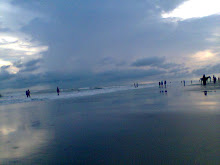
Though the lineal development of Bengal sculpture is best understood with the help of the Buddha and the Visnu images as found in different centres of art in Bihar and Bengal, they represent mostly a single compositional type, that is of samapda or strictly frontal vertical form. But there are representations of other images, as of the Buddhist goddess Marichi or the Brahmanical goddess Mahisasuramardini, which show figures in diagonal pose, while the images of Yashoda and Krishna (?), also known as sadyajata or new born, and of Anantashayi-Visnu or Visnu lying on the snake Ananta represent examples of horizontal compositions. It is possible to witness other still more sophisticated forms, which include such images as of the Tantric-Buddhist deity Vajratara in the collection of Indian Museum. From the aesthetic viewpoint more significant however are the dancing figures of Ganesha and Shiva-Nataraja. An example of the former from the collection of Asutosh Museum, found at Hajinagar, Rajshahi, shows an excellent combination of curvacious modelling, rhythmic movement and flowing contour lines.
But still more interesting seems to be the Siva-Nataraja, both in concept and executional refinement. Most of the Shiva-Nataraja (fig 14) images have been found in the districts of Dhaka and Tippera in south-east extreme of Bengal. These images stand in contrast with those of south Indian Natarajas. Here the god is dancing in a soft cadence on his vehicle bull, who is also dancing in the corresponding rhythm of his Master, while the south Indian Nataraja dances in tandava, pressing under his feet the evil form of Apasmara. A supreme example of Siva-Nataraja, inscriptionally designated as Nattesvara, of Bengal version is now in the National Museum, Dhaka. (14 of 16)
But still more interesting seems to be the Siva-Nataraja, both in concept and executional refinement. Most of the Shiva-Nataraja (fig 14) images have been found in the districts of Dhaka and Tippera in south-east extreme of Bengal. These images stand in contrast with those of south Indian Natarajas. Here the god is dancing in a soft cadence on his vehicle bull, who is also dancing in the corresponding rhythm of his Master, while the south Indian Nataraja dances in tandava, pressing under his feet the evil form of Apasmara. A supreme example of Siva-Nataraja, inscriptionally designated as Nattesvara, of Bengal version is now in the National Museum, Dhaka. (14 of 16)

No comments:
Post a Comment